Belgium
Count Louis II De Male
1346-84 Silver 2 Groot 30mm (4.12 grams)
Reference: VGF# 223-225
Certification: NGC VF DETAILS 5747206-013
LVDOVICUS: DEI: GRA: COMES: Z: DNS: FLANDRIE, Seated lion with tournament helmet.
MOИETA THE FLANDRIA + BEИEDICTUS: QUI: VEИIT: IИ: ИOMIИE: DOMIИI, Legend in two circles around short flowered cross.
Coin Notes:
Between the 8th of february 1366 and the 28th of february 1384, 23.216.450 coins were minted in Ghent and 6.384.176 were minted in Malines. There are several legend variants. You are bidding on the exact item pictured, provided with a Certificate of Authenticity and Lifetime Guarantee of Authenticity.
.svg/150px-Coat_of_Arms_of_the_Count_of_Flanders_(according_to_the_Gelre_Armorial).svg.png) Louis II (Dutch: Lodewijk van Male; French: Louis II de Flandre) (25 October 1330, Male – 30 January 1384, Lille), also known as Louis of Male, a member of the House of Dampierre, was count of Flanders, Nevers and Rethel from 1346 as well as count of Artois and Burgundy from 1382 until his death. Louis II (Dutch: Lodewijk van Male; French: Louis II de Flandre) (25 October 1330, Male – 30 January 1384, Lille), also known as Louis of Male, a member of the House of Dampierre, was count of Flanders, Nevers and Rethel from 1346 as well as count of Artois and Burgundy from 1382 until his death.
Louis was the son of Count Louis I of Flanders, and Countess Margaret I of Burgundy, daughter of King Philip V of France. He was baptised by Bishop Pierre Roger (later Pope Clement VI). His father arranged his marriage with Margaret, daughter of Duke John III of Brabant, in the course of the rapprochement to the Imperial Duchy of Brabant. They had a daughter, Countess Margaret III of Flanders (1348–1405). Louis also had several illegitimate sons, three of whom were killed at the Battle of Nicopolis. When his father was killed at the Battle of Crécy against the troops of King Edward III of England in 1346, he inherited the French counties of Flanders, Nevers, and Rethel. In the Anglo-French conflict, the Flanders guilds, depending on the English wool trade, forced Louis to recognize King Edward III as his overlord and arranged an engagement to the daughter of the English king, Isabella. Louis managed to avoid this by fleeing to the court of King Philip VI of France. In 1347 he married Margaret of Brabant, which sparked a revolt in Ghent. Nevertheless, while the Black Death devastated the county and after Louis came to terms with the English king and in 1349 he could return to Flanders to succeed his father. In 1350 Louis gained credence by openly refusing to pay homage to the newly ascended King John II of France. When his father-in-law John III died without male heirs in 1355, he moved to claim the Duchy of Brabant, but was unable to wrest it from his sister-in-law Joanna. Though Louis managed to defeat the Brabantian forces in the Battle of Scheut near Anderlecht (17 August 1356) and capture the cities of Mechelen, Brussels, Antwerp, and Leuven, but he was unable to prevail against Joanna, backed by her husband Duke Wenceslaus I of Luxembourg and his mighty brother Emperor Charles IV. By the 1357 Peace of Ath he at least gained the rule over the small Lordship of Mechelen and the thriving city of Antwerp. Louis tried to govern as a realpolitiker and continued a policy of neutrality, which kept him in favor with both France and England during the continued conflicts of the Hundred Years' War, initiating a period of stability and relative affluence in Flanders. With regards to his internal policy, his main aim was to prevent the formation of a broad coalition against him, as happened against his father. Except for his last years, he was successful in preventing this. In 1357 Louis II had his seven-year-old daughter Margaret marry the minor Duke Philip I of Burgundy. Philip died from plague four years later. As heir presumptive to her father's territories, she was a highly coveted bride courted by both Edmund of Langley, son of King Edward III of England, and Philip the Bold, son of King John II of France and the new duke of Burgundy since 1363. After several years of tough bargaining, Count Louis II gave his consent to Philip and his brother King Charles V of France. In return he received the lordships of Romance Flanders (Lille, Douai, Orchies) and a payment of 200,000 livre tournois. The marriage of Margaret and Philip was celebrated at Saint Bavo Cathedral in Ghent on 19 June 1369. Though a capable ruler, Louis' lavish lifestyle burdened his county's finances and caused increasing disturbances. However, even in his latter years he managed to get the support of the Bruges citizens against revolting Ghent. The latter years of his rule were nevertheless marked by civil strife. In 1379, he obtained aid from his son-in-law, Philip the Bold, to put down another Ghent revolt. The Flemings again rose in 1382 under Philip van Artevelde and expelled Count Louis from Flanders after the Battle of Beverhoutsveld; however, the influence of Philip the Bold procured a French army to relieve him, and the Flemings were decisively defeated at the Battle of Roosebeke. The citizens of Ghent continued to resist (with English aid) until after his death in 1384. His mother, Margaret, had died two years previously, leaving him the County of Artois and the Free County of Burgundy (Franche-Comté).
 Belgium, officially the Kingdom of Belgium, is a sovereign state in Western Europe. It is a small, densely populated country which covers an area of 30,528 square kilometres (11,787 sq mi) and has a population of about 11 million people. Belgium, officially the Kingdom of Belgium, is a sovereign state in Western Europe. It is a small, densely populated country which covers an area of 30,528 square kilometres (11,787 sq mi) and has a population of about 11 million people.
Straddling the cultural boundary between Germanic and Latin Europe, Belgium is home to two main linguistic groups: the Dutch-speaking, mostly Flemish community, which constitutes about 59% of the population, and the French-speaking, mostly Walloon population, which comprises 41% of all Belgians. Additionally, there is a small group of German-speakers who live in the East Cantons located around the High Fens area, and bordering Germany. 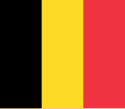 Belgium is a federal constitutional monarchy with a parliamentary system of governance. It is divided into three regions and three communities, that exist next to each other. Its two largest regions are the Dutch-speaking region of Flanders in the north and the French-speaking southern region of Wallonia. The Brussels-Capital Region, officially bilingual, is a mostly French-speaking enclave within the Flemish Region. A German-speaking Community exists in eastern Wallonia. Belgium's linguistic diversity and related political conflicts are reflected in its political history and complex system of government. Belgium is a federal constitutional monarchy with a parliamentary system of governance. It is divided into three regions and three communities, that exist next to each other. Its two largest regions are the Dutch-speaking region of Flanders in the north and the French-speaking southern region of Wallonia. The Brussels-Capital Region, officially bilingual, is a mostly French-speaking enclave within the Flemish Region. A German-speaking Community exists in eastern Wallonia. Belgium's linguistic diversity and related political conflicts are reflected in its political history and complex system of government.
 Historically, Belgium, the Netherlands and Luxembourg were known as the Low Countries; it once covered a somewhat larger area than the current Benelux group of states. The region was called Belgica in Latin, after the Roman province of Gallia Belgica. From the end of the Middle Ages until the 17th century, the area of Belgium was a prosperous and cosmopolitan centre of commerce and culture. From the 16th century until the Belgian Revolution in 1830, when Belgium seceded from the Netherlands, the area of Belgium served as the battleground between many European powers, causing it to be dubbed the "Battlefield of Europe," a reputation strengthened by both world wars. Historically, Belgium, the Netherlands and Luxembourg were known as the Low Countries; it once covered a somewhat larger area than the current Benelux group of states. The region was called Belgica in Latin, after the Roman province of Gallia Belgica. From the end of the Middle Ages until the 17th century, the area of Belgium was a prosperous and cosmopolitan centre of commerce and culture. From the 16th century until the Belgian Revolution in 1830, when Belgium seceded from the Netherlands, the area of Belgium served as the battleground between many European powers, causing it to be dubbed the "Battlefield of Europe," a reputation strengthened by both world wars.
Upon its independence, Belgium participated in the Industrial Revolution and, during the course of the 20th century, possessed a number of colonies in Africa. The second half of the 20th century was marked by rising tensions between the Dutch-speaking and the French-speaking citizens fueled by differences in language and the unequal economic development of Flanders and Wallonia. This continuing antagonism has led to several far-reaching reforms, resulting in a transition from a unitary to a federal arrangement during the period from 1970 to 1993. Despite the reforms, tensions between the groups remain; the formation of a coalition government took 18 months following the June 2010 federal election. Belgium is a founding member of the European Union, Eurozone, NATO, OECD and WTO, and a part of the trilateral Benelux Union. Its capital, Brussels, hosts several of the EU's official seats as well as the headquarters of many major international organizations such as NATO. Belgium is also a part of the Schengen Area. Belgium is a developed country, with an advanced high-income economy and is categorized as "very high" in the Human Development Index.
|
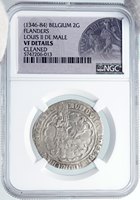
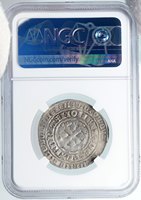
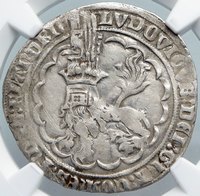
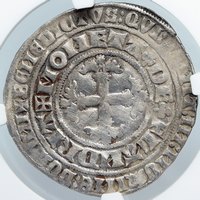
.svg/150px-Coat_of_Arms_of_the_Count_of_Flanders_(according_to_the_Gelre_Armorial).svg.png) Louis II (Dutch: Lodewijk van Male; French: Louis II de Flandre) (25 October 1330, Male – 30 January 1384, Lille), also known as Louis of Male, a member of the House of Dampierre, was count of Flanders, Nevers and Rethel from 1346 as well as count of Artois and Burgundy from 1382 until his death.
Louis II (Dutch: Lodewijk van Male; French: Louis II de Flandre) (25 October 1330, Male – 30 January 1384, Lille), also known as Louis of Male, a member of the House of Dampierre, was count of Flanders, Nevers and Rethel from 1346 as well as count of Artois and Burgundy from 1382 until his death. Belgium, officially the Kingdom of Belgium, is a sovereign state in Western Europe. It is a small, densely populated country which covers an area of 30,528 square kilometres (11,787 sq mi) and has a population of about 11 million people.
Belgium, officially the Kingdom of Belgium, is a sovereign state in Western Europe. It is a small, densely populated country which covers an area of 30,528 square kilometres (11,787 sq mi) and has a population of about 11 million people. Belgium is a federal constitutional monarchy with a parliamentary system of governance. It is divided into three regions and three communities, that exist next to each other. Its two largest regions are the Dutch-speaking region of Flanders in the north and the French-speaking southern region of Wallonia. The Brussels-Capital Region, officially bilingual, is a mostly French-speaking enclave within the Flemish Region. A German-speaking Community exists in eastern Wallonia. Belgium's linguistic diversity and related political conflicts are reflected in its political history and complex system of government.
Belgium is a federal constitutional monarchy with a parliamentary system of governance. It is divided into three regions and three communities, that exist next to each other. Its two largest regions are the Dutch-speaking region of Flanders in the north and the French-speaking southern region of Wallonia. The Brussels-Capital Region, officially bilingual, is a mostly French-speaking enclave within the Flemish Region. A German-speaking Community exists in eastern Wallonia. Belgium's linguistic diversity and related political conflicts are reflected in its political history and complex system of government. Historically, Belgium, the Netherlands and Luxembourg were known as the Low Countries; it once covered a somewhat larger area than the current Benelux group of states. The region was called Belgica in Latin, after the Roman province of Gallia Belgica. From the end of the Middle Ages until the 17th century, the area of Belgium was a prosperous and cosmopolitan centre of commerce and culture. From the 16th century until the Belgian Revolution in 1830, when Belgium seceded from the Netherlands, the area of Belgium served as the battleground between many European powers, causing it to be dubbed the "Battlefield of Europe," a reputation strengthened by both world wars.
Historically, Belgium, the Netherlands and Luxembourg were known as the Low Countries; it once covered a somewhat larger area than the current Benelux group of states. The region was called Belgica in Latin, after the Roman province of Gallia Belgica. From the end of the Middle Ages until the 17th century, the area of Belgium was a prosperous and cosmopolitan centre of commerce and culture. From the 16th century until the Belgian Revolution in 1830, when Belgium seceded from the Netherlands, the area of Belgium served as the battleground between many European powers, causing it to be dubbed the "Battlefield of Europe," a reputation strengthened by both world wars.
